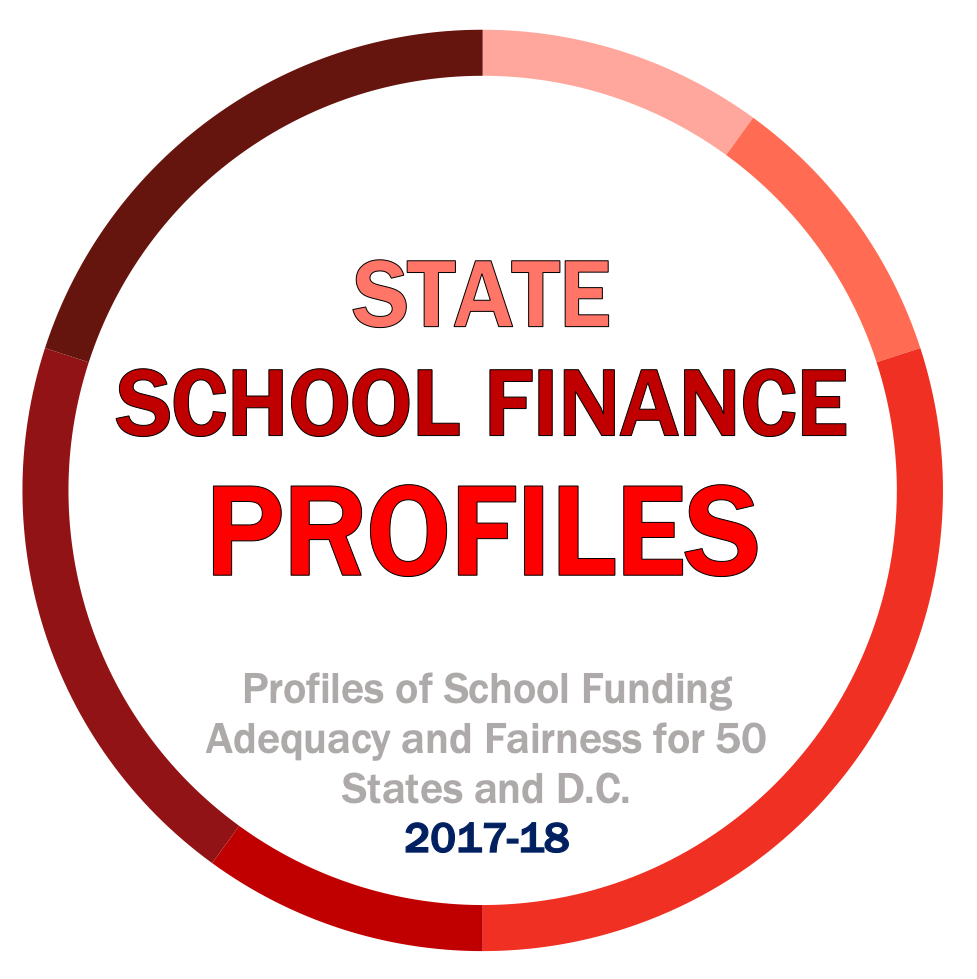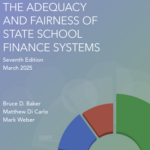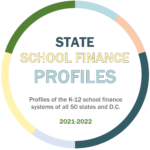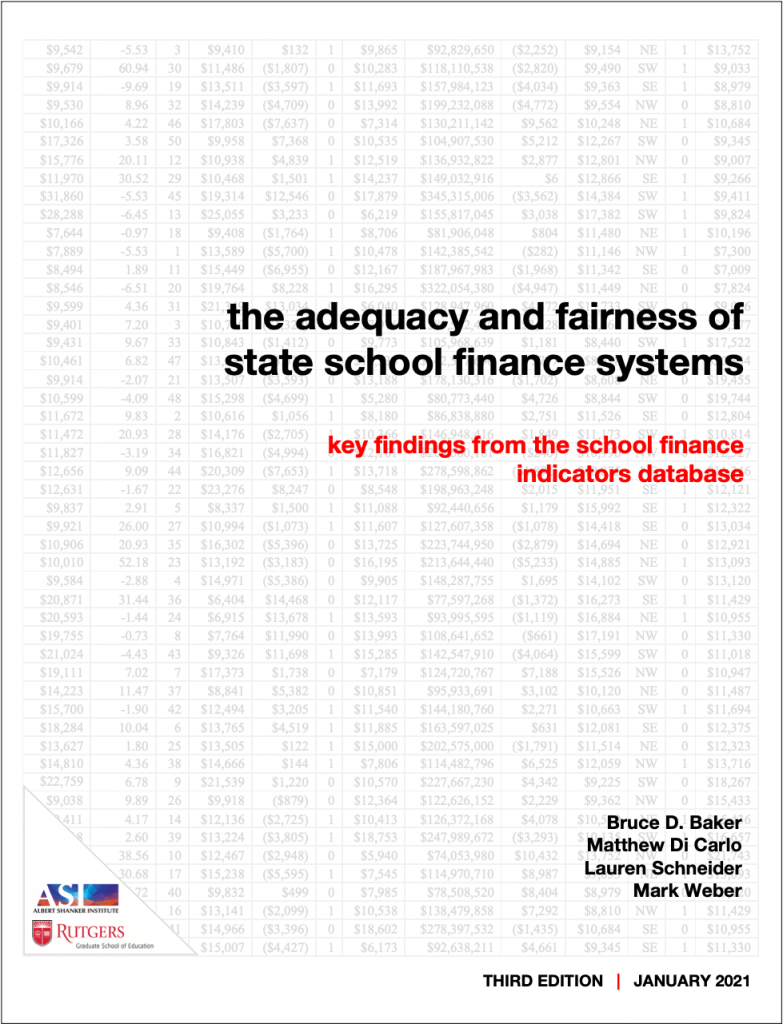The Adequacy and Fairness of State School Finance Systems
Third Edition (January 2021)
Download: full report | executive summary | press release | state finance profiles
The publication of this annual report and accompanying database is motivated by two considerations. The first is that there is now an emerging empirical consensus about the centrality of equitable and adequate funding for high-quality K-12 education. Yes, how money is spent is also important, but there are few options for improving U.S. public schools that do not require investment of resources, and districts cannot spend wisely money they do not have. The research is clear: Money matters. Period.
The second consideration is that school finance is extremely complicated. The inner workings of states’ funding systems, shaped over decades in state legislatures and courts, are so intricate and complex that few truly understand how they work. And finance research is among the most arcane and impenetrable fields for policymakers, parents and the general public. Every year, countless reports of varying quality are published by a variety of different individuals and organizations, sometimes reaching inconsistent conclusions.
The primary purpose of the School Finance Indicators Database (SFID) is to cut through this clutter. It is a public collection of finance and resource allocation measures that are based on sophisticated and widely accepted methods but are also designed to be easy for non-researchers to interpret and use themselves.
The State Indicators Database (SID), which is the SFID’s primary product, includes approximately 125 variables, but we focus in this report on three key school finance measures: fiscal effort, adequacy, and progressivity. We feel that these three indicators as a whole provide a succinct and informative overview of the adequacy and fairness of each state’s school finance system.
This third edition of our database and annual report, however, is being published in the middle of a terrible global crisis: the coronavirus pandemic. Due to the lag in the release of national school finance data, our measures (2017-18 school year) predate the economic crisis caused by this pandemic. Yet this is precisely the right time to examine and evaluate states’ school finance systems, as they will play a big role in determining the severity, duration and distribution of the school budget shortfalls. Accordingly, we pay special attention in this report to discussing how states’ systems tend to mediate the impact of economic downturns, and we offer general guidance as to what we can expect as the impact of the current crisis continues to unfold over the next few years.

Fiscal effort
Fiscal effort (or simply effort) measures how much of states’ total economic capacity is spent directly on K-12 education. It is fundamentally less a measure of how much states spend than the degree to which they leverage their potential to spend. Our effort indicators allow us to determine whether states lag behind in spending because they don’t have the capacity to raise revenue (e.g., they have smaller economies from which to draw tax revenue), or because they refuse to devote sufficient resources to their public schools.
- States vary in their effort levels, which, along with state capacity, drive large interstate differences in school resources.
- Individual states’ effort levels range from about 2.4 percent of gross state product (GSP) in Hawaii and Arizona to 4.4-4.5 percent in Wyoming and New Jersey. That is, New Jersey and Wyoming devote almost twice as much of their “economic pies” to public schools as do Hawaii and Arizona. (Figure 3)
- Higher-effort states generally produce more revenue, though states with larger economies can produce the same amount of revenue as states with smaller economies that put forth the same effort levels. Effort and capacity together explain roughly 70-80 percent of interstate differences in adjusted state and local revenue. (Figure 4)
- The Great Recession, in combination with policymakers’ choices in its aftermath, caused what appears to be a permanent decline in fiscal effort.
- Average U.S. effort increased from roughly 3.8 percent in 2004 to a high of 4.1 percent in 2009. This was followed by a rapid four-year decline between 2009 and 2013, during which time the average decreased from 4.1 to 3.5 percent. It has remained relatively flat since 2013. States’ economies recovered, but most failed to revisit their funding systems to make up lost ground. (Figure 5)
- Between 2007 and 2018, there was at least a nominal net decrease in effort in all but nine states (and even small changes in effort represent large changes in resources). In several states—such as Florida, Hawaii, Indiana and Michigan—this decrease was close to or greater than one percentage point.
- As a result, in 40 states, effort was lower in 2018 than it was in 2004, 14 years earlier.
- Most states are in a worse position to handle the current economic crisis than they were prior to the Great Recession.
- High-effort, low-capacity states are particularly vulnerable. These states, such as Arkansas, Mississippi and South Carolina, are already spending a relatively large share of their “economic pies” on education and are more limited in their ability to increase resources.
- Most states’ effort levels will likely increase in the short term, and decline afterward. The initial increase is an illusion of sorts, as it tends to take some time for education budget cuts to “catch up” with the immediate economic contraction caused by recessions. Without significant federal and state level policy responses, decreases in effort may once again recur for several years and not subsequently recover, representing another long-term de facto cut in school funding.
Adequacy
Effort measures how hard states and districts work to raise funds for their public schools, while adequacy addresses whether the amount raised is enough. Our primary measure of adequacy compares each state’s current education spending, by district poverty level, to estimates of spending levels that would be required to achieve national average test scores. In other words, we define adequacy in terms of a common benchmark (national average scores) that is educationally meaningful, using estimates from models that take into account factors such as student characteristics, labor market costs and district characteristics.
- In the vast majority of states, spending in high-poverty districts falls far short of estimated adequate levels.
- On average, spending in the highest-poverty districts (80-100th percentile poverty) is approximately 20 percent below our estimated adequate levels. (Figure 7)
- There are only nine states in which spending on the highest-poverty districts exceeds estimated adequate levels: Wyoming; New York; New Hampshire; Nebraska; Alaska; Connecticut; D.C.; North Dakota; and Delaware. (Figure 8)
- Conversely, spending in the highest-poverty districts is at least 20 percent below the adequate level in 28 states, and at least 40 percent lower in eight of these states: Arizona; New Mexico; Texas; Mississippi; California; Nevada; Oklahoma; and Alabama.
- The situation is not much better in the second highest poverty district quintile (60-80th percentile district poverty), where spending is above adequate levels in only 19 states.
- In contrast, spending in lower-poverty districts is above estimated adequacy targets in most states. When it comes to their lowest-poverty (0-20th percentile) districts, 41 states spend above estimated adequacy targets, by an average of 45 percent. In the second-lowest district poverty quintile (20-40th percentile), spending is above adequate levels in 30 states, by an average of 11 percent.
- There is a positive relationship between adequacy and fiscal effort. That is, states that spend a larger slice of their “economic pies” on education tend to exhibit more adequate spending levels. Adequate spending in no small part represents a policy choice. (Figure 10)
-
Higher-poverty districts (and states) are particularly vulnerable during the current economic downturn, and most are already spending below adequate levels.
-
The negative impact of budget cuts on spending adequacy will be more severe and persistent in higher-poverty districts, as lower-income districts are generally hit harder by state revenue cuts, and are less well-equipped to recover from them.
-
Federal aid should be targeted at high-effort states with inadequate funding. States such as Mississippi and New Mexico try to raise their own revenue but are constrained in their ability to do so. Low-effort states with inadequate funding, in contrast, have more flexibility to generate resources in house.
-
Progressivity
Put simply, progressive funding systems are those in which higher-poverty districts, all else being equal, receive more revenue than lower-poverty districts. Regressive funding systems, in contrast, allocate more funding to wealthier districts than they do to poorer districts. Progressivity (sometimes called “fairness”) is important because it is generally well established that students from marginalized backgrounds tend to require more resources than their more affluent peers to achieve the same level of education outcomes. Our primary progressivity measure compares revenue between high- (30 percent Census child poverty) and zero-poverty districts while controlling for factors—such as labor market costs, population density and district size—that affect the value of the education dollar.
- State and local education revenue in most states is either non-progressive or regressive. That is, high-poverty districts, all else being equal, tend to receive revenue that is similar to or less than that allocated to the lowest-poverty districts in the same state.
- There are only 10 states in which high-poverty districts receive at least 10 percent more revenue than zero-poverty districts. In only four of these states (Alaska, Utah, Nebraska, and Minnesota) do high-poverty districts receive at least 25 percent more. (Figure 12)
- In 25 states, high-poverty districts actually receive less revenue than zero-poverty districts. Funding is particularly regressive in Nevada, New Hampshire, Illinois, Delaware and Maine.
- At the national level, education funding has been non-progressive for the past two decades. On average, labor market-centered state and local revenue in the highest-poverty districts has been within 2-3 percentage points of that in the lowest-poverty districts since 1998. (Figure 13)
- The Great Recession reversed a decade of slow progress in improving the fairness of education funding.
- Between 1998 and 2008, 35 states saw at least a nominal net increase in progressivity.
- During and after the recession, however, most states saw a net decrease in revenue fairness—in 32 states, funding was less progressive in 2018 than in 2008. Even as states’ economies recovered, the damage to funding equity persisted.
- Due to the pandemic-fueled economic downturn, increasing inequity of education funding is likely in the short term, but policymakers can limit and reverse the damage.
- School funding in many states will likely become more regressive during the next two to four years. This shift could be even more pronounced and persistent than it was during and after the Great Recession, as revenue from property taxes, which are regressive, declined due to the collapse of the housing market in 2007-08, but hopefully will remain more stable during this current downturn.
- The magnitude of these shifts, and how long they last, is largely in the hands of policymakers. The current distribution of state revenue, how it is cut, and its interplay with local revenue will shape these trends. For example, states can cut aid in a manner that minimizes harm to higher-poverty districts, and reform their systems going forward to ensure a more progressive distribution of K-12 revenue.
Overall, then, resources in most states tend to be allocated regressively or non-progressively, and funding for higher-poverty districts in the vast majority of states falls far short of estimated adequacy levels (in many cases reflecting a lack of effort). These results are particularly troubling in our current economic situation, which threatens to make a bad situation worse.
Yet our findings also highlight the heterogeneity of states’ school finance systems. There are, in fact, several states in which education funds are both adequate and distributed equitably, and there are relatively few that perform poorly on all three of our core measures. Such diversity is a result of the fact that school finance is primarily in the hands of states, and the structure and performance of systems thus varies widely among those states.
The impact of the current economic crisis on K-12 funding will likewise differ among states that were at a variety of different “starting positions” when the pandemic began. And it bears emphasizing that state policymakers have the ability to mediate the severity of the damage, how long it lasts, and whether the burden is borne disproportionately by districts serving higher-needs students.
Finally, while the purpose of this report (and the SFID in general) is to describe and evaluate states’ school finance systems, we do not provide overall state ratings or grades. Due to the complex interdependency of our three core measures, as well as the importance of state contextual factors, the potential for single summative measures to mislead and oversimplify outweighs their benefits. We do, however, include recommendations as to how policymakers, journalists, parents, and the public can use our data and results to summarize and assess the performance of state school finance systems.
We have once again made our State Indicators Database, which includes many measures not presented in this report, freely available to the public. Also accompanying this report are one-page profiles of the school finance systems of all 50 states and the District of Columbia, which may be particularly useful to those interested in one state or a small group of states. It is our hope that these data and analyses will improve school finance debates and policymaking in the U.S., both during this current economic crisis and beyond.
Read the full report (PDF)
Read the executive summary or press release (PDF)
View individual state finance profiles
Download the full dataset or use online data visualizations
Authors: Bruce D. Baker (Rutgers University); Matthew Di Carlo (Albert Shanker Institute); Lauren Schneider (Albert Shanker Institute); Mark Weber (Rutgers University)
View previous editions of this report
Latest News
 UPDATED ANNUAL REPORT, PROFILES, AND DATASETS AVAILABLE
UPDATED ANNUAL REPORT, PROFILES, AND DATASETS AVAILABLE
March 2025: Read the seventh edition of our annual report, view your state’s one-page finance profile, use our data visualizations, or download the full state- and district-level dataset.
Latest Annual Report
 The Adequacy and Fairness of State School Finance Systems (7th edition)
The Adequacy and Fairness of State School Finance Systems (7th edition)
The seventh edition of our annual report presenting findings on effort, statewide adequacy, and equal opportunity in state school finance systems. Published March 2025.
Latest Research Briefs
 State School Finance System Profiles (2021-22 school year)
State School Finance System Profiles (2021-22 school year)
One-page profiles summarizing the key results on effort, statewide adequacy, and equal opportunity for all 50 states and D.C. View your state’s profile. Published March 2025.





